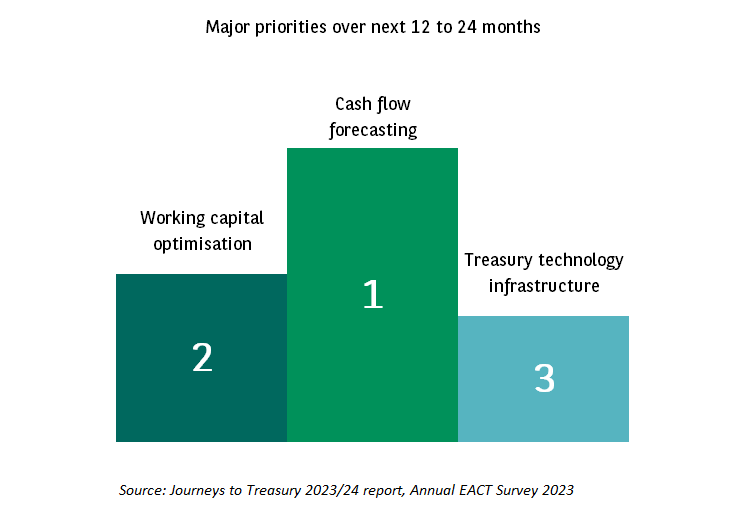The annual Journeys to Treasury report, published during EuroFinance in Barcelona by BNP Paribas, together with PwC, SAP and the European Association of Corporate Treasurers (EACT), offers insights into the trends, challenges and priorities for treasury teams and finance professionals across the EMEA region, now and in the future. This includes a focus on innovation, new technologies and techniques in the treasury field.
Visibility on future cash flows is the top priority
Results from the 2023/24 European Association of Corporate Treasurers (EACT) survey revealed a strong focus on cash flow forecasting, data analytics, and centralisation among treasurer respondents. More than 43% of European treasurers see transparency on cash flow forecasting as their primary focus for the next 12 to 24 months, to inform decisions when managing investments, exposures, hedging, and raising debt. Working capital optimisation and treasury technology infrastructure were other priorities. This resonates with treasurers’ primary concerns across the globe, as seen in the Key Treasury Challenges Survey in Asia Pacific.

While budgets can often be a stumbling block, innovative solutions to enhance operations and improve processes can bring obvious benefits. Centralising all single European payments area (SEPA) direct debits and SEPA credit transfers to deliver best-in-class pricing for the media-giant Mediahuis, BNP Paribas set up a zero-balancing cash pool, provided the company with excellent grounds for negotiating first-rate credit renumeration and debit interest, and enabled the group to focus on longer-term strategic projects and mergers and acquisitions (M&A). An area where treasury can add real value to the business. To date, BNP Paribas has centralised more than 10 million direct debits for Mediahuis.

❝ Supporting our treasurer clients with cutting edge technology, innovative and efficient solutions that help them meet their core objectives of risk mitigation, control, and visibility over cash is key, particularly in turbulent times. ❞
The regulatory burden is increasing
Regulation is a further consideration that could potentially add significant administrative and financial burdens on treasurers. Currently with the European Parliament, real-time, or instant payments, are – alongside discussions around intercompany transaction exemptions and hedging definitions – one of the main pressure points for treasury departments at the current time.

❝ It’s important that the treasurer is aware of the new proposed regulation on e-invoicing within the EU, the proposal of ViDA (VAT in the Digital Age). This is a tax transparency obligation for all Europe, which will become very important for all treasurers around the continent. It is an opportunity to digitise that which is rarely digitalised. ❞
European treasurers are also exploring various ways to help support their organisations’ ESG agendas, mainly via green bonds and other sustainable borrowing. The survey revealed that few large corporates have a treasury policy to cover ESG measurements and reporting, meaning that they must start preparing for future ESG reporting.
Forthcoming regulation:
1. European Market Infrastructure Regulation (EMIR)
2. Money Market Funds (MMFs)
3. PSD2 regulation / PSD3 review
4. Proposed EU regulation on VAT in the Digital Age
5. Introduction of instant payments
Innovation, data analytics and APIs are top of mind
When it comes to technology innovations, data analytics and APIs are top of mind for European treasurers. Centralisation and standardisation are further topics of great interest over the next 12 to 24 months. Adding artificial intelligence (AI) and machine learning (ML) to the treasury mix could bring the treasury function to entirely new levels. Collecting and processing the vast volumes of data flowing through the function in a secure, comparable, and centralised way is essential for these tools to deliver optimal outcomes. Adding in real-time data capture via APIs and cloud solutions could yield significant efficiency gains, and provide valuable analytical insight, to manage risks and capture future opportunities.

❝ A lack of standardisation creates additional layers of complexity for corporates trying to centralise APIs. My vision is to develop more of those standard APIs that allow for specific purposes, such as the return of funds, for example. ❞
In a recent partnership between BNP Paribas and fintech Sis ID, aimed at collectively reducing risk exposure, a unique repository shared by more than 15,000 companies was created to certify the data of third parties via a private blockchain. The data is then made available to Sis ID clients, either via call APIs or by secured website. Connecting its Enterprise Resource Planning (ERP) to BNP Paribas’ Kantox foreign exchange (FX) platform via API, employees of L’OCCITANE Group can manage and monitor multicurrency FX exposures in real time, increasing reliability and allowing employees to focus on higher value-added tasks.
In the 2022 TMI Awards, the Bank was awarded ‘Best Bank for Cash and Liquidity Management in Europe’ as well as the ‘Global Bank of the Year for ESG’. A number of our clients won ‘Corporate Recognition Awards’ for their successful projects with BNP Paribas.

Looking ahead
Heightened regulatory and compliance requirements alongside increasingly complex corporate structures and legal entities make a good case for implementing efficiency measures: reducing manual processes to value added tasks, increasing automation and standardisation. Other key areas of focus in the years to 2025 are regulation, real-time processes, with reporting and dashboarding, liquidity, and payments and collections.
